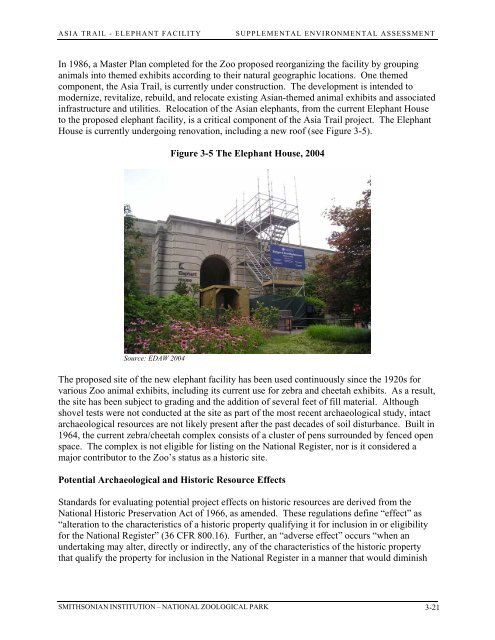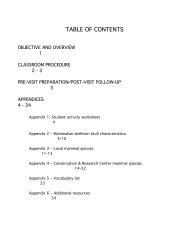asia trail elephant facility - National Zoo - Smithsonian Institution
asia trail elephant facility - National Zoo - Smithsonian Institution
asia trail elephant facility - National Zoo - Smithsonian Institution
You also want an ePaper? Increase the reach of your titles
YUMPU automatically turns print PDFs into web optimized ePapers that Google loves.
ASIA TRAIL - ELEPHANT FACILITY SUPPLEMENTAL ENVIRONMENTAL ASSESSMENT<br />
In 1986, a Master Plan completed for the <strong>Zoo</strong> proposed reorganizing the <strong>facility</strong> by grouping<br />
animals into themed exhibits according to their natural geographic locations. One themed<br />
component, the Asia Trail, is currently under construction. The development is intended to<br />
modernize, revitalize, rebuild, and relocate existing Asian-themed animal exhibits and associated<br />
infrastructure and utilities. Relocation of the Asian <strong>elephant</strong>s, from the current Elephant House<br />
to the proposed <strong>elephant</strong> <strong>facility</strong>, is a critical component of the Asia Trail project. The Elephant<br />
House is currently undergoing renovation, including a new roof (see Figure 3-5).<br />
Source: EDAW 2004<br />
Figure 3-5 The Elephant House, 2004<br />
The proposed site of the new <strong>elephant</strong> <strong>facility</strong> has been used continuously since the 1920s for<br />
various <strong>Zoo</strong> animal exhibits, including its current use for zebra and cheetah exhibits. As a result,<br />
the site has been subject to grading and the addition of several feet of fill material. Although<br />
shovel tests were not conducted at the site as part of the most recent archaeological study, intact<br />
archaeological resources are not likely present after the past decades of soil disturbance. Built in<br />
1964, the current zebra/cheetah complex consists of a cluster of pens surrounded by fenced open<br />
space. The complex is not eligible for listing on the <strong>National</strong> Register, nor is it considered a<br />
major contributor to the <strong>Zoo</strong>’s status as a historic site.<br />
Potential Archaeological and Historic Resource Effects<br />
Standards for evaluating potential project effects on historic resources are derived from the<br />
<strong>National</strong> Historic Preservation Act of 1966, as amended. These regulations define “effect” as<br />
“alteration to the characteristics of a historic property qualifying it for inclusion in or eligibility<br />
for the <strong>National</strong> Register” (36 CFR 800.16). Further, an “adverse effect” occurs “when an<br />
undertaking may alter, directly or indirectly, any of the characteristics of the historic property<br />
that qualify the property for inclusion in the <strong>National</strong> Register in a manner that would diminish<br />
SMITHSONIAN INSTITUTION – NATIONAL ZOOLOGICAL PARK 3-21
















